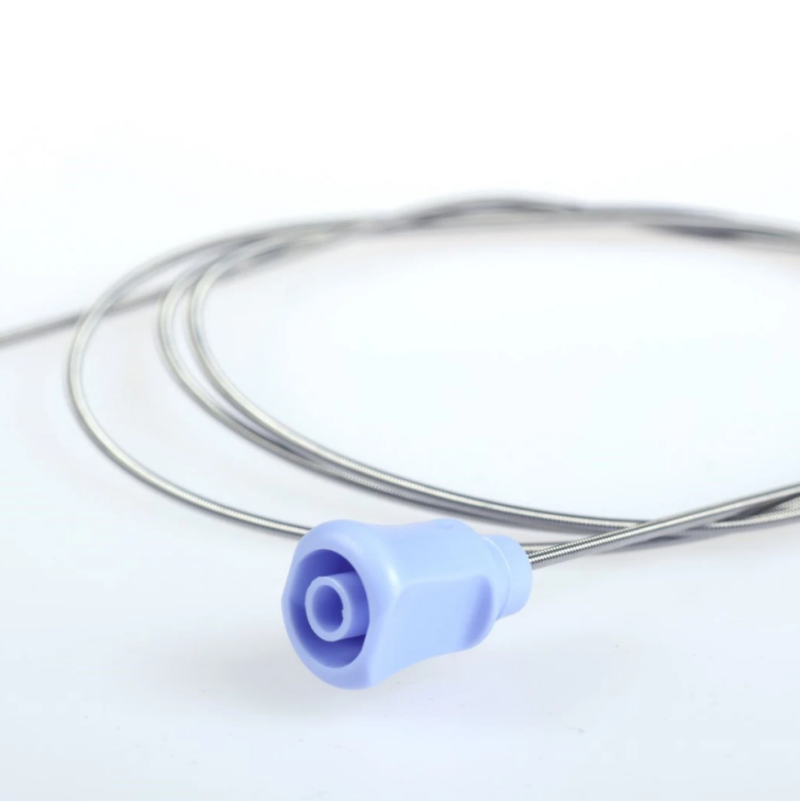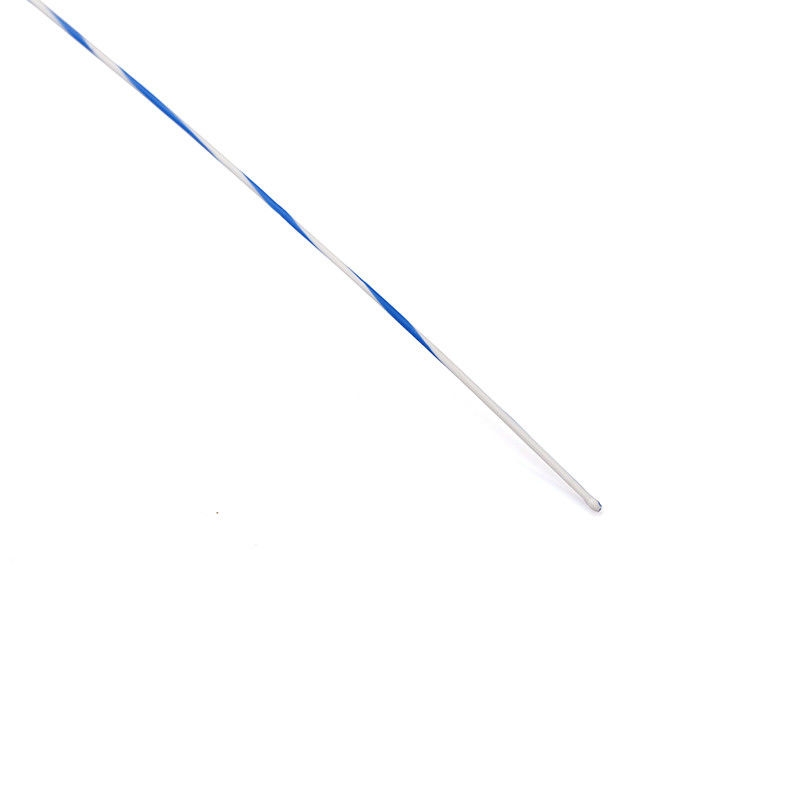Nasal feeding tubes are crucial in medical practice for enteral feeding, medication administration, gastric decompression, and managing gastrointestinal bleeding, offering vital support to patients unable to consume food orally. The Demax nasal feeding tube guidewire serves as a specialized tool aiding healthcare providers in the accurate placement of nasogastric tubes. Renowned for its flexibility, visibility, and maneuverability, this guidewire is essential for ensuring the safe and precise insertion of the nasogastric tube. Guidewire plays a pivotal role in navigating nasal passages and the esophagus, facilitating the accurate positioning of the feeding tube.

Understanding Nasal Feeding Tube
Definition and Types of Nasal Feeding Tube
Nasal feeding tubes are slender, flexible medical devices inserted through the nose into the stomach or small intestine. They include various types such as nasogastric (NG) tubes, reaching the stomach, and nasojejunal (NJ) tubes, extending to the small intestine. These tubes are crucial for delivering essential nutrition, fluids, and medications directly to patients who cannot orally consume food, ensuring they receive the necessary treatment and sustenance.
Common Medical Conditions Requiring Nasal Feeding Tube
The nasal feeding tube is commonly employed for patients facing challenges in oral feeding due to conditions like severe dysphagia caused by neurological disorders (e.g., stroke or ALS), cancers affecting the head, neck, or esophagus, and critical illnesses requiring long-term nutritional support. They are also used in managing gastrointestinal disorders such as gastroparesis and severe gastroesophageal reflux disease (GERD), providing vital assistance in maintaining patient health and recovery.
Importance of Nasal Feeding Tube Guidewire
Role of Guidewire in Nasal Feeding Tube Insertion Procedures
Guidewires play a pivotal role in the precise placement of nasal feeding tubes. They offer essential support and guidance during insertion, assisting healthcare providers in navigating through nasal passages, the esophagus, and the stomach with accuracy. This ensures proper tube placement, reducing the risk of complications associated with misalignment.
Benefits of Using Guidewire for Placement Accuracy and Patient Comfort
The use of guidewire enhances the accuracy of nasal feeding tube insertion, minimizing the potential for incorrect positioning that could lead to adverse health outcomes. Guidewire also contributes significantly to patient comfort by facilitating smoother and less traumatic insertions. Their controlled guidance helps prevent discomfort and minimizes tissue trauma in delicate nasal and esophageal tissues, thereby improving overall patient experience and safety.
Demax Nasal Feeding Tube Guidewire
Advanced Features for Optimal Performance
Demax nasal feeding tube guidewire features an advanced super-lubricious hydrophilic coating designed to facilitate seamless advancement through nasal passages, the esophagus, and into the stomach. This coating reduces friction during insertion, minimizing the risk of tissue damage. The guidewire’s soft, tapered tip enhances ease of navigation through anatomical structures, ensuring minimal patient discomfort and tissue trauma.
Key Benefits and Specifications
Key benefits of the Demax guidewire include its nitinol alloy core, providing exceptional flexibility and durability for navigating complex anatomical pathways with ease. Radiopaque markers enhance visibility under fluoroscopy, ensuring accurate tube positioning during procedures. The guidewire’s disposable design eliminates the need for reprocessing, reducing the risk of cross-contamination and maintaining high standards of patient safety.

Application Fields
Facilitating Enteral Feeding and Medication Administration
The Demax Nasogastric Tube Guidewire plays a crucial role in precisely placing nasogastric tubes for enteral feeding and medication administration. This ensures that patients unable to consume food orally receive essential nutrients and medications directly into their stomachs or small intestines, effectively supporting their nutritional and therapeutic requirements.
Assisting in Gastric Decompression
In scenarios such as gastric obstruction, ileus, or gastrointestinal bleeding, the Demax guidewire aids in safely decompressing the stomach. Helping healthcare professionals relieve pressure and remove stomach contents, alleviates symptoms and prevents further complications associated with these conditions.
Managing Gastrointestinal Bleeding
The guidewire is indispensable in diagnosing and managing gastrointestinal bleeding. Its precise placement of nasogastric tubes enables prompt evaluation and treatment of bleeding sites within the gastrointestinal tract, crucial for stabilizing patients and initiating appropriate therapies.
Ensuring Accurate Diagnostic Imaging
During diagnostic imaging procedures of the gastrointestinal tract, the Demax guidewire ensures precise placement of nasogastric tubes. This accuracy is essential for using contrast agents effectively to visualize conditions, aiding in accurate diagnosis and guiding subsequent treatment plans.
Supporting Surgical Procedures
In various surgical contexts like laparotomy and laparoscopy, the Demax guidewire facilitates optimal visualization and access to the gastrointestinal tract. This assistance enables surgeons to perform precise and minimally invasive interventions, thereby enhancing overall surgical outcomes.
Insertion Techniques and Procedures
Step-by-Step Guide to Nasal Feeding Tube Guidewire Use
Using a nasal feeding tube guidewire involves several critical steps to ensure safe and accurate placement. Beginning with assessing and lubricating the patient’s nostrils and nasal passages, the guidewire is gently inserted and advanced through the nasal passage, esophagus, and into the stomach or small intestine. Continuous monitoring and adjustment are essential to guide the guidewire along the correct path. Once positioned accurately, the nasogastric tube is threaded over the guidewire and placed precisely where needed.
Ensuring Patient Safety During Insertion
Maintaining patient safety during insertion requires adherence to stringent protocols and best practices. This includes using sterile techniques to prevent infections, ensuring adequate lubrication for smooth passage of the guidewire, and vigilant monitoring for any signs of patient discomfort or complications. Proper training and adherence to established procedures are crucial to minimize risks and ensure the procedure’s success.
Safety Considerations
Prioritizing Sterile Technique and Infection Control
Maintaining a sterile environment throughout the insertion process is paramount to prevent infections that could lead to serious complications. Healthcare providers must strictly follow disinfection protocols for all equipment used. Ensure patient safety and minimize the risk of postoperative infection.
Understanding Risks and Potential Complications
Nasogastric tube insertion is generally safe, but there are potential risks. Examples include nasal or esophageal trauma, improper intubation, and infection. Be aware of these risks, coupled with careful technique and constant vigilance. It is vital to mitigate complications and ensure the overall success and safety of the surgery.
Maintenance and Care
Guidelines for Cleaning and Sterilizing Nasal Feeding Tube Guidewire
Proper maintenance of nasal feeding tube guidewires includes thorough cleaning and sterilization after each use, following manufacturer guidelines, and utilizing appropriate sterilization methods. This ensures that the guidewires remain free from contaminants and safe for future procedures. Regular inspection for wear and tear is also crucial to maintain their functionality and reliability.
Storage Practices for Longevity and Safety
To maintain the integrity and functionality of the nasogastric tube guidewire. Proper storage in a clean, dry and sterile environment is essential. Adhering to recommended storage practices will help prevent damage and contamination. Ensures that the guidewire maintains its effectiveness and reliability during repeated clinical use.
In Closing
Nasogastric feeding tubes play a vital role in medical practice. Supports enteral feeding, medication management, gastric decompression, and management of gastrointestinal bleeding in patients unable to eat orally. The Demax nasal feeding tube guidewire is a specialized tool that healthcare providers rely on for accurately placing nasogastric tubes. Known for its flexibility, visibility, and maneuverability, this guidewire ensures safe and precise tube insertion. By navigating the nasal passages and esophagus effectively, guidewires contribute significantly to improving patient care and safety through accurate feeding tube positioning.
